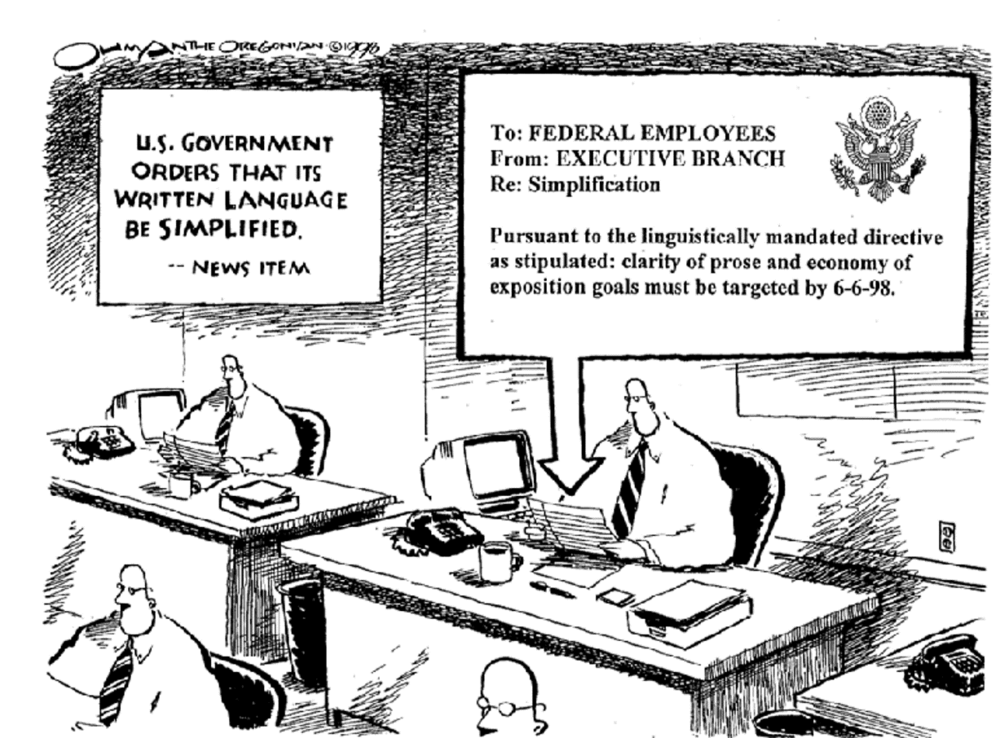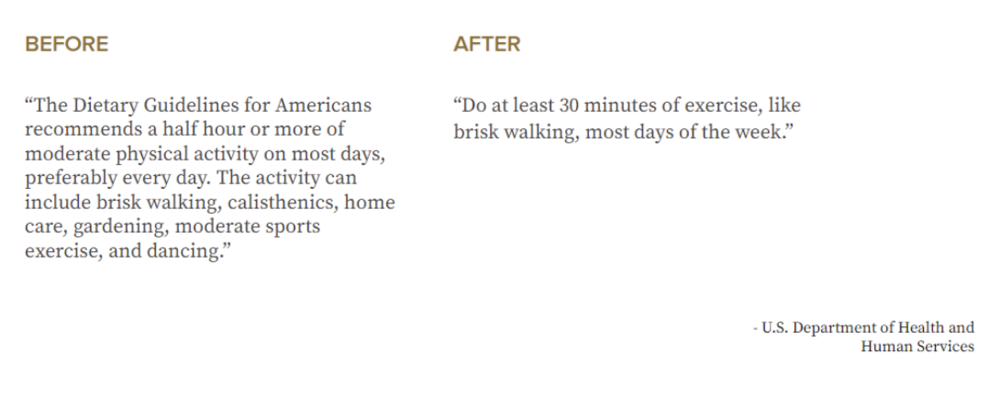
February 09, 2023
There's No Fine Print in Government Websites
The Necessity of Plain Language
“If you want me to give you a two-hour presentation, I’m ready today. If you want only a five-minute speech, it will take me two weeks to prepare.”
Mark Twain’s quote speaks to the importance of plain language, which is defined by communication that is clear, concise, and easily understood. It strives to eliminate the need for complex sentence structures or words often used in jargon, making it simpler for readers or listeners to understand the message. But plain language is not only about avoiding complicated words or phrases; it also involves writing in a familiar style, using visuals where appropriate, and making it accessible to all audiences.
In terms of government agencies, plain language is especially important as agencies must be able to communicate with constituents from all walks of life. And, because government documents and websites often contain regulations, laws, policies, and procedures that must be followed for people to receive services or benefits, these communications need to be written in a way that can be easily understood. Writing too “governmenty”— using complicated words, unfamiliar jargon, and long sentences — makes the process more difficult for everyone.
All of this becomes even more evident when considering accessibility issues. For example, if someone has a disability that makes reading difficult or speaks English as a second language, then using plain language helps ensure that they can access, understand, and take advantage of any services offered by their local agency. Accessibility also means writing content at an appropriate grade level so that all audiences can understand it.
Less is More

When creating digital content, more is not necessarily better. Too much information can lead users down rabbit holes and make them feel lost and overwhelmed. When people visit government agency websites, they are typically looking for a specific piece of information or to complete a task. The last thing they want is to navigate through a maze of options to find what they need. In fact, in most cases, more information creates more opportunities for duplication, conflicting messages and abandonment of the task altogether. So, part of managing your website content is knowing what to leave off and even eliminate it when it is no longer relevant.
For example, consider how inundated you already are with information everywhere. What we need is certainly not more. Think about your own online website habits. How do you scan your phone or websites? If you’re like most of us, you spend only an average of 26 seconds reading any given piece of content. When clicking around a website, we typically spend less than 15 seconds on a particular web page. And then it takes our brain a mere 17 milliseconds to make a judgment about what we just clicked to determine if it is relevant or interesting to us. So, by keeping things straightforward and providing only the most pertinent details, you will ultimately be offering an optimal user experience.
It’s The Law

Beyond convenience and user experience considerations, plain language is now on the law books. In recent years there have been various initiatives by the federal government to promote the use of plain language. In 2010 and 2012, for example, President Obama signed legislation that said government laws, policies, regulations, and then publications, websites, forums, documents, etc. must all be written in “clear language that the public can understand and use.”
This legislation is also what prompted the creation of the Plain Language.gov website, which offers resources and guidance on how to use plain language effectively in government communication. Please see further resources at the end of this blog.
Examples
As you can see in the following examples, translating information into plain language makes the messages much more accessible. As Mark Twain also once said, “I notice that you use plain, simple language, short words and brief sentences. That is the way to write English — it is the modern way and the best way.”


Writing simply doesn’t necessarily mean it’s easy. It means that the effort should be on the part of the writer, not the reader. As the French mathematician and philosopher Pascal famously wrote in his "Lettres Provinciales" in 1657, "If I had more time, I would have written a shorter letter.”
Which States Actually Do This?
Some states have executive orders to implement plain language, including Oregon, Florida, Minnesota, New Jersey and Washington. Georgia doesn’t have plain language guidelines – yet. But, as part of our work with the Digital Center of Excellence, the state may come to an agreement this year. Here’s a look at what a few of these other states are already doing.
Oregon has six requirements:
- Use everyday words that convey meanings clearly and directly.
- Use the present tense and the active voice.
- Use short simple sentences.
- Defines only words that cannot be properly explained or qualified in the text.
- Use type/fonts of a readable size.
- Use layout and spacing that separate the paragraphs and sections of the document from each other.
Similarly, in Florida they require clear language that is commonly used by the intended audience, only the information needed by the recipient presented in a logical sequence, short sentences written in the active voice that make it clear who is responsible for what, and a layout and design that helps the reader understand the meaning on the first try, such as adequate white space, bulleted lists, and helpful headings.
In Minnesota, they recommend the following five steps: plan, organize, write, edit, and review.
- Plan before you write. Talk about what you’re writing with communications, legal, and subject matter experts. Talk about the content’s purpose. Know your reader, their situation, and how they will receive the information.
- Organize the information so it’s easy to understand. Select the right (and right amount) of content. Arrange the information logically and format it for easy use.
- Write the way you speak. Use everyday language. Use active voice. Keep sentences short.
- Edit with your reader in mind. What questions will they have? What do they need to know now? Would a list or table make something easier to understand?
- Review what you’ve written. If you can put your document down for a while and come back to it for a fresh look. Test it with real users.
Putting Plain Language into Practice
We're helping pave the way with our GovHub digital publishing platform, but there are still steps that content managers can take in order to ensure that their websites offer visitors a positive experience every time they visit. Let’s talk about a few ways you can implement plain language right away. Here’s a quick list of 10 practical skills for incorporating plain language into your website content:
- Write for your reader, not for yourself.
- It’s okay to use pronouns when you can.
- Stick to your topic.
- Limit each paragraph to one idea and keep it short.
- Write in the active voice. You use passive voice only in rare cases.
- Use short sentences.
- Use everyday words to explain technical terms and explain technical terms probably.
- Omit unneeded words.
- Keep the subject and verb close together.
- Use headings lists and tables to make things easier.
Online training
Because U.S. government agencies are required to communicate in plain language, there are several online training resources available. Here are a few.
- The Plain Language Action and Information Network (PLAIN) through Digital.gov held two online workshops to explain how to write in plain language. 8-11-2020 workshop and 9-10-2020 workshop. The two workshops are very similar.
- The Centers for Disease Control and Prevention offers an online health literacy training for health professionals.
- A Toolkit for Making Written Material Clear and Effective was created by the Centers for Medicare and Medicaid Services, which focuses on healthcare and health literacy, but any discipline can apply its principles.
- If you want to better understand what plain language is, why you should use it, and how to write in plain language, check out the Department of Defense training
- The Department of the Army’s training for staff officers is available as a PDF.
- A nine part training titled The Essentials of Plain Language is details plain language principles and the Plain Language Writing Act of 2010.
- The Federal Aviation Administration’s plain language toolkit is available online.
- Everyone can use help learning to organize ideas, use a clear writing style, and become a more effective communicator. That’s the goal of the National Institutes of Health’s free plain language training course. And it’s not just for medical personnel.
- If you’d like to study the principles of plain language in Spanish, the government of Mexico kicked off a program in 2004 encouraging plain language in government writing. You can download the compressed file of the materials here.
